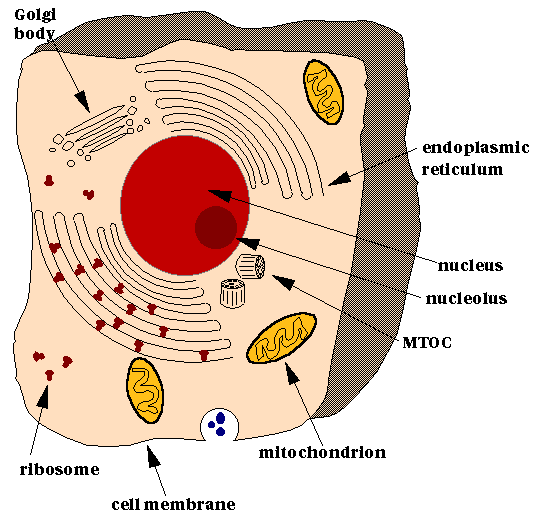



Eukaryota: More on Morphology






What makes a eukaryote a eukaryote? The name means "true nut" or "true kernel" in Greek; the "nut" is in fact the nucleus of the eukaryotic cell, a membrane sac that contains the cell's DNA. Unlike bacteria and archaea, eukaryotes have their DNA in linear pieces that are bound up with special proteins (histones) to make chromosomes (normally visible only in dividing cells).
The cytoskeleton is another feature unique to the eukaryotes. It is a network of protein filaments, mostly actin and tubulin, which are anchored to the cell membrane, and criss-cross the periphery of the cell. The network provides a structural framework which gives the cell its shape, and stabilizes the membrane systems. It also permits the cell to selectively exert tension on the membrane, making movement of the cell possible. The contractibility of these protein filaments are also responsible for muscle function, and the operation of the spindle apparatus, which separates the chromosomes during mitosis.
Both eukaryotes and bacteria may move with "flagella" - long threadlike structures that propel the organism through liquid. However, the eukaryote flagellum is completely different in structure from that of a bacterium; some scientists prefer to use the word "undulipodium" for a eukaryotic flagellum, to emphasize this difference. An undulipodium is a bundle of nine pairs of microtubules surrounding a central pair (the so-called 9+2 structure). At the base of a eukaryotic flagellum is a microtubule organizing center, or MTOC. In animals, MTOCs also function in creating the arrays of microtubules that pull the chromosomes apart during cell division.
The endoplasmic reticulum, or ER for short, is a complex network of membranes that provides a transport system within the cell. There are two types of endoplasmic reticulum, rough and smooth. Smooth endoplasmic reticulum is the site of lipid (fat and oil) formation, and is also the site where cells detoxify poisons; your liver cells are rich in smooth ER. Rough ER is the site of protein formation and transport; it is called "rough" because it is studded with ribosomes, which are small organelles that synthesize protein. Golgi bodies, which are most common in secretory cells, package cell products, such as enzymes, into vacuoles for transport to the outside.
Almost all eukaryotes contain other complex organelles. Mitochondria, shown here, are the cell's "powerhouses," the sites where aerobic respiration breaks down food in the presence of oxygen into water and carbon dioxide, generating energy. Plants and many protists also contain plastids, where photosynthesis takes place, allowing these organisms to manufacture their own food from carbon dioxide and water. Chloroplasts and mitochondria are curious organelles indeed; they contain their own DNA and replicate independently. In fact, these organelles are descendants of symbiotic bacteria living inside the eukaryote host. They have become so dependent on their host that they can no longer live outside. This may also be the case with MTOCs, although the evidence is less clear in this case. Eukaryotes - including humans - are, in a very real sense, not individual organisms but colonies, and living proof that evolution frequently does not proceed according to the violent stereotypes of continuous struggle, of "nature red in tooth and claw." Sometimes the winning strategy is cooperation.
Compare the diagram above with this transmission electron micrograph of rat liver cells (212 K). Two cells are shown, with both nuclei visible, as well as the thin junction between the cells. Many mitochondria are present, along with abundant endoplasmic reticulum.
You may view a movie of cytoskeleton dynamics at the Cells Alive! website.


